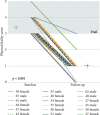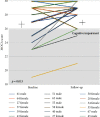Reversibility of Frailty after Lung Transplantation
- PMID: 32850137
- PMCID: PMC7439792
- DOI: 10.1155/2020/3239495
Reversibility of Frailty after Lung Transplantation
Abstract
Background: Frailty contributes to increased morbidity and mortality in patients referred for and undergoing lung transplantation (LTX). The study aim was to determine if frailty is reversible after LTX in those classified as frail at LTX evaluation.
Methods: Consecutive LTX recipients were included. All patients underwent modified physical frailty assessment during LTX evaluation. For patients assessed as frail, frailty was reassessed on completion of the post-LTX rehabilitation program. Frailty was defined by the presence of ≥ 3 domains of the modified Fried Frailty Phenotype (mFFP).
Results: We performed 166 lung transplants (frail patients, n = 27, 16%). Eighteen of the 27 frail patients have undergone frailty reassessment. Eight frail patients died, and one interstate recipient did not return for reassessment. In the 18 (66%) patients reassessed, there was an overall reduction in their frailty score post-LTX ((3.4 ± 0.6 to 1.0 ± 0.7), p < 0.001) with 17/18 (94%) no longer classified as frail. Improvements were seen in the following frailty domains: exhaustion, mobility, appetite, and activity. Handgrip strength did not improve posttransplant.
Conclusions: Physical frailty was largely reversible following LTX, underscoring the importance of considering frailty a dynamic, not a fixed, entity. Further work is needed to identify those patients whose frailty is modifiable and establish specific interventions to improve frailty.
Copyright © 2020 Elyn Montgomery et al.
Conflict of interest statement
The authors declare no conflicts of interest.
Figures






References
-
- Weill D., Benden C., Corris P. A., et al. A consensus document for the selection of lung transplant candidates: 2014-an update from the pulmonary transplantation council of the international society for heart and lung transplantation. The Journal of Heart and Lung Transplantation. 2015;34(1):1–15. doi: 10.1016/j.healun.2014.06.014. - DOI - PubMed
LinkOut - more resources
Full Text Sources

